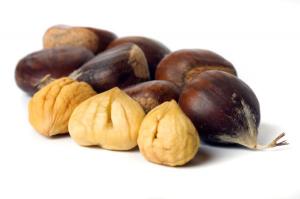
Chestnuts
€ Core price
The European chestnut is a deciduous tree belonging to the family of Fagaceae which originates from Western Europe. It grows in the Mediterranean area, in a region that extends from the Iberian peninsula to the Caucasian regions near the Black Sea. In Europe this plant is widespread in the western countries: Portugal, Spain, France, England, Italy, Slovenia and Croatia; in the southern countries of Bosnia and Montenegro and in most regions of Albania, Macedonia and Greece; and in the western regions of Turkey and northern Turkey along the Black Sea up to the Caucasus.
Health Benefits
The chestnut is a fruit that meets the increasing popularity of traditional and natural foods because its cultivation does not necessitate the use of phytochemicals, complying fully with the requirements of organic agriculture. Unlike most fleshy fruits (apples, peaches etc…) their water content is relatively low at around 50% in fresh product. Because of its high sugar content the fruit’s calorifc properties are helpful in cases of physical and mental lack of strength and for sportsmen and individuals subject to stress. Due to their sugar content chestnuts are recommended as an alternative for children who are allergic to cow’s milk or who are lactose intolerant. Chestnut four is used as a source of carbohydrate as a replacement in the preparation of desserts and dough for individuals who are intolerant to cereals. The fibre content is considered very important for healthy gut motility; for balanced micro flora, and for the reduction of high cholesterol. It is recommended in diets to prevent gastrointestinal disturbances by accelerating the transit of substances in the intestinal tract.
Supplier


Company

Website
 Italy
Italy
Country
Product details
Place of processing
-
Origin of main ingredient

Origin of main ingredient

Packaging formats

Packaging

Composition


